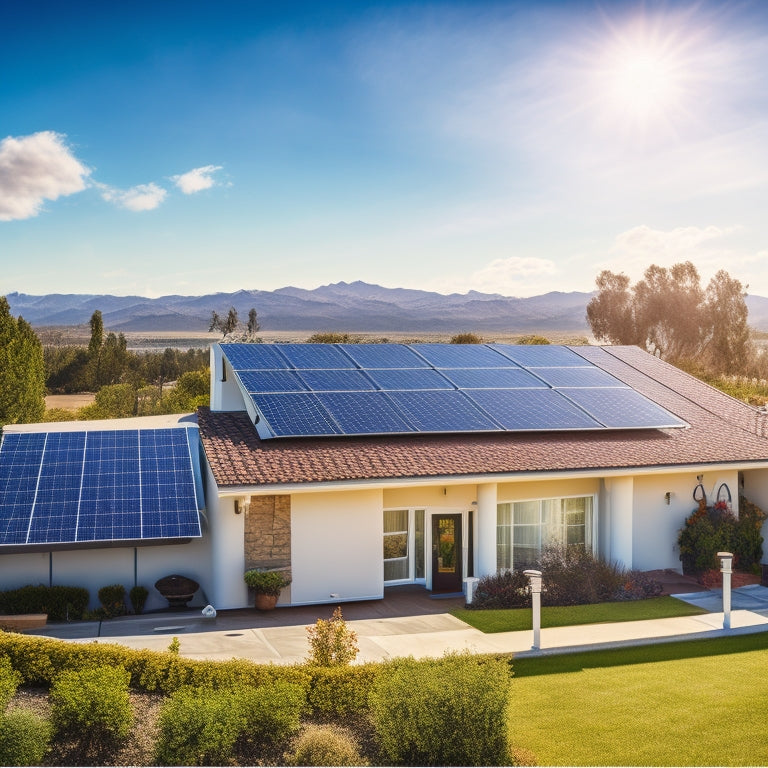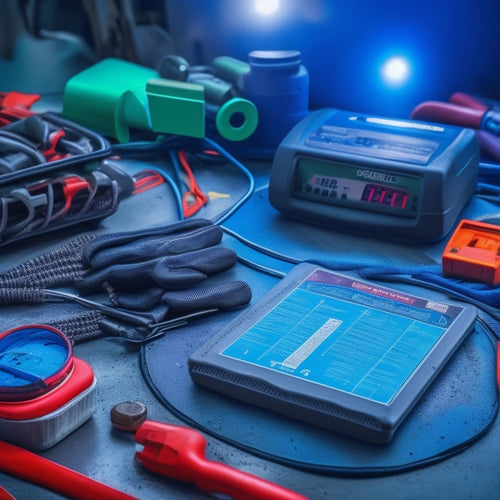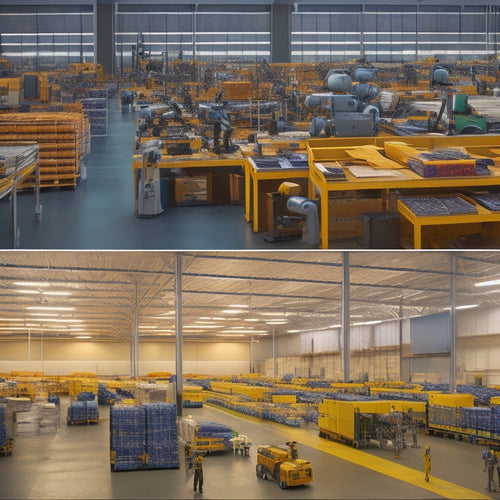
What's the Cost of California Residential Panels?
Share
You're contemplating installing solar panels in California, but you're wondering how much it'll set you back. The cost of California residential solar panels varies widely, ranging from $10,000 to $40,000 or more, depending on factors like system size, equipment quality, and installation complexity. Additionally, incentives like federal tax credits and California rebates can greatly impact the final cost. To get a better grasp on the price tag, it's crucial to understand the various factors at play and how they affect your investment. As you explore your options, you'll want to take into account all the details that influence the cost and benefits of California residential solar panels.
Key Takeaways
• The cost of California residential panels ranges from $10,000 to $40,000+, depending on system size and equipment quality.
• Additional installation costs can range from $500 to $2,000, depending on complexity and features.
• Federal tax credits and California Solar Initiative rebates can reduce the upfront cost by up to 26% and $0.95 per watt, respectively.
• The average annual savings from installing residential panels in California is $600 to $1,500, with a return on investment in 4-9 years.
• The cost of maintenance and inspection is $100 to $500, recommended every 3-6 months and 6-12 months, respectively, to ensure optimal performance.
California Solar Panel Prices
Your cost for California solar panels can vary greatly depending on the type and quality of equipment, installation company, and local permits. As you consider investing in solar energy, it's crucial to understand the factors influencing the cost of California solar panels.
The type of solar panels you choose, for instance, can greatly impact your overall expenditure. High-efficiency panels, while more expensive, can provide higher energy output and potentially increase your savings.
California regulations also play a vital role in determining the cost of solar panels. The state's net metering policy, which allows you to sell excess energy back to the grid, can help offset the initial investment. Additionally, California's Energy Storage Initiative, which encourages the adoption of energy storage systems, can also affect the cost.
Residential Installation Costs
When exploring the costs of California residential solar panels, you'll discover that residential installation costs are a significant factor.
You'll need to take into account how system size affects your overall expenditure, as well as how varying installation factors, such as labor costs and permits, impact your bottom line.
System Size Matters
When determining the cost of residential solar panels in California, the system size you choose has a significant impact on your overall installation costs. A larger system will naturally cost more, but it'll also generate more electricity and increase your energy efficiency. You'll want to evaluate your energy needs and assess your space planning to determine the best system size for your home.
A smaller system may be suitable for a smaller home or one with limited roof space, while a larger system is often needed for larger homes or those with higher energy demands. It's crucial to balance your energy needs with the available space on your roof.
A system that's too small won't meet your energy needs, while one that's too large will be a waste of resources. By choosing the right system size, you can maximize your energy efficiency, reduce your energy bills, and increase your savings.
Installation Factors Vary
How do installation factors like labor costs, local permits, and equipment quality impact the overall residential installation costs in California?
When contemplating the installation of solar panels, it's important to recognize that these factors can greatly influence the final cost of your project.
Here are some key installation factors to keep in mind:
-
Labor costs: The expense of hiring a licensed and experienced installer can vary depending on the location and complexity of the project.
-
Local permits and building codes: Adhering to California's building codes and obtaining necessary permits can contribute to the overall cost. Neighborhood restrictions, such as homeowners' association rules, may also affect the installation process and cost.
-
Equipment quality: The type and quality of solar panels, inverters, and mounting hardware can have a significant impact on the upfront cost of the system.
These installation factors can add thousands of dollars to the overall cost of your solar panel system.
As you navigate the installation process, it's important to understand how these factors will affect your project's bottom line.
Per-Watt Pricing
Your cost per watt of installed solar power in California typically ranges from $2.50 to $3.50, depending on the system's size, equipment quality, and installation complexity. This per-watt pricing is a key factor in determining the overall cost of your residential solar panel installation. When evaluating quotes from different installers, it's crucial to take into account the price per watt, as it can greatly impact your total expenditure.
In California's Energy Markets, the cost of solar power has decreased significantly over the years, making it more competitive with traditional Rate Structures. However, the per-watt pricing can still vary depending on the specific requirements of your installation. For instance, a larger system with high-efficiency panels and a complex installation may cost closer to $3.50 per watt, while a smaller system with standard equipment might be priced around $2.50 per watt.
When comparing quotes, be sure to inquire about the per-watt pricing and what it includes. This will help you make an informed decision and ensure you're getting the best value for your investment.
Average Cost Per Watt
You can expect to pay an average of $2.75 to $3.25 per watt for a standard residential solar panel system in California. This price range is relatively important compared to other states, making California an attractive market for homeowners looking to harness the power of solar energy.
The average cost per watt is a vital factor in determining the overall cost of your solar panel system. A lower cost per watt can lead to significant Cost Savings over time, especially when combined with the state's incentives for renewable energy. Additionally, a more efficient system can provide more energy while reducing your carbon footprint, resulting in improved Energy Efficiency.
Here are some key takeaways to consider:
- A 5-kW system would cost between $13,750 and $16,250
- A 10-kW system would cost between $27,500 and $32,500
- Larger systems can provide even greater cost savings and energy efficiency benefits
Factors Affecting Solar Costs
As you consider the cost of California residential solar panels, you'll find that several factors influence the final price tag.
You'll need to think about the system size and quality, as well as the complexity of your roof, since these elements can greatly impact your overall costs.
Additionally, local installation costs will also play a role in determining your total expenditure.
System Size and Quality
The size and quality of a solar panel system greatly impact its overall cost. Larger systems and higher-efficiency panels generally increase the upfront investment. As you consider your solar panel options, it's essential to understand how system size and quality affect the overall cost.
Here are some key factors to keep in mind:
-
Panel Efficiency: Higher-efficiency panels produce more energy per hour of sunlight, but are typically more expensive. If you have limited roof space, high-efficiency panels might be the best option.
-
Energy Output: A larger system will generally produce more energy, but also increases the upfront cost. You'll need to balance your energy needs with your budget.
-
Premium Components: High-quality inverters, mounting systems, and other components can increase the system's overall cost, but also provide longer warranties and better performance.
Roof Size and Complexity
Your roof's size and complexity greatly influence the cost of your California residential solar panel installation, with larger, more intricate roofs often requiring additional materials and labor.
The more complex your roof's architecture, the more challenging the installation process becomes. For instance, roofs with multiple skylights, vents, or unusual angles may require specialized equipment and extra labor to guarantee a secure and efficient installation. This, in turn, increases the overall cost of the project.
Additionally, the structural integrity of your roof is a critical factor in determining the cost of your solar panel installation. If your roof requires additional reinforcement or repairs to support the weight of the solar panels, this will add to the overall expense.
Moreover, if your roof is particularly large or has an unusual shape, you may need more solar panels to generate the same amount of power, which can also drive up costs. By understanding how your roof's size and complexity impact the cost of your solar panel installation, you can better plan and budget for your project.
Local Installation Costs
California's varying labor costs, permitting fees, and local incentives have a significant impact on the overall expense of residential solar panel installations, making it important to take into account these location-specific factors when budgeting for your project.
As you plan your solar panel installation, it's vital to take into consideration the local installation costs that can affect your project's overall cost.
Some key factors to take into account include:
-
Labor laws and regulations: California has strict labor laws, which can increase labor costs. Make sure your installer complies with these regulations to avoid additional fees.
-
Permit fees: Permit fees vary by city and county, ranging from $500 to $2,000. Research the permit fees in your area to factor them into your budget.
-
Local incentives and rebates: Some California cities and counties offer additional incentives or rebates for residential solar installations. Research these local incentives to maximize your savings.
System Size and Cost
Deciding on the right system size for your residential solar panel installation greatly impacts your upfront cost. A larger system size means more panels, which translates to a higher cost. However, a bigger system also means more energy production, leading to increased energy efficiency and cost savings in the long run.
When determining the ideal system size, consider your energy usage and the amount of space available for installation. A system that's too small won't meet your energy needs, while an oversized system will be a waste of resources. You'll want to strike a balance between energy production and cost.
A typical residential solar panel system ranges from 3 to 10 kilowatts (kW).
A 5kW system, for example, would be suitable for a small to medium-sized home with moderate energy consumption. As system size increases, so does the cost. A 10kW system, for instance, would be considerably more expensive than a 5kW system.
Roof Size and Orientation
As you consider installing residential solar panels in California, you'll need to assess your roof's size and orientation to determine the best placement of your panels.
The available roof space will impact the number of panels you can install, and the orientation will affect the system's energy production.
Roof Space Availability
Your roof's size and orientation greatly impact the number of residential solar panels you can install, with larger roofs generally accommodating more panels. However, it's not just about the size; the orientation of your roof also plays an essential role.
A south-facing roof with little to no shading is ideal for solar panel installation. But what if your roof has obstacles or architectural constraints?
Here are some factors to take into account when evaluating your roof's space availability:
-
Roof obstacles: Chimneys, vents, skylights, and other protrusions can reduce the available space for solar panels.
-
Architectural constraints: Complex rooflines, multiple peaks, and valleys can make it difficult to find suitable space for panels.
-
Shading: Trees, neighboring buildings, or other structures can cast shadows on your roof, reducing the effectiveness of solar panels.
Optimal Panel Placement
With an understanding of your roof's space availability, you'll want to optimize panel placement to maximize energy production, and that starts with evaluating your roof's size and orientation. A south-facing roof with minimal shading is ideal, but not always possible. That's why a thorough shading analysis and obstruction assessment are essential in determining the best panel placement.
| Roof Orientation | Energy Production |
|---|---|
| South-facing | 100% |
| East/West-facing | 80-90% |
| North-facing | 50-70% |
As shown in the table, a south-facing roof receives the most direct sunlight, resulting in maximum energy production. East- and west-facing roofs receive indirect sunlight, resulting in slightly lower energy production. North-facing roofs receive the least amount of direct sunlight, resulting in the lowest energy production. By understanding your roof's size and orientation, you can strategically place your panels to maximize energy production and reduce energy costs.
Local Incentives and Rebates
You can greatly reduce the upfront cost of California residential solar panels by tapping into local incentives and rebates, which vary by utility company and municipality. These incentives can markedly lower your initial investment, making solar energy more accessible and affordable.
Some of the local incentives and rebates you can explore include:
-
Property Tax Exclusion: California's Property Tax Exclusion allows you to exclude the value of your solar panel system from your property's taxable value, reducing your property tax liability.
-
Government Grants: You may be eligible for government grants, such as the California Energy Commission's (CEC) Solar Initiative, which provides funding for solar installations in underserved communities.
-
Utility Rebates: Many utility companies, like PG&E and SCE, offer rebates for residential solar panel installations, which can help offset the upfront cost.
Solar Panel Quality Matters
While incentives and rebates can greatly reduce the upfront cost of California residential solar panels, the quality of the panels themselves plays an essential role in determining the long-term performance and overall value of your solar investment.
High-quality solar panels are designed to maximize energy efficiency, converting a higher percentage of sunlight into usable electricity. This means you'll generate more power per hour of sunlight, reducing your reliance on the grid and saving you more money on your utility bills.
Additionally, reputable manufacturers typically offer lengthy warranties, often up to 25 years or more, ensuring that your investment is protected in case anything goes wrong. Warranty importance can't be overstated, as it provides a safeguard against defects and premature degradation.
Installation Company Costs
The cost of hiring a reputable installation company can add a significant amount to your overall expenditure, but it's important to guarantee that your system is installed correctly to maximize its energy output and longevity. A reputable company will make sure that your system is installed safely and efficiently, which can save you money in the long run.
Here are some factors to keep in mind when evaluating installation company costs:
-
Company reputation: Research the company's reputation online and ask for referrals to ensure you're hiring a trustworthy and experienced installer.
-
Labor costs: Labor costs vary depending on the company's expertise, location, and the complexity of the installation. Expect to pay between $2,000 to $5,000 for a standard residential installation.
-
Warranty and support: A reputable company will offer a thorough warranty and dedicated customer support, which can provide peace of mind and protect your investment.
Ongoing Maintenance Expenses
Regular cleaning and inspections are crucial to guaranteeing your solar panel system operates at peak performance. Factoring these ongoing maintenance expenses into your overall budget is essential. You'll need to allocate funds for regular cleaning to remove dirt, debris, and other obstructions that can reduce energy output. Depending on your location and climate, you may need to clean your panels every 6-12 months, with costs ranging from $100 to $300 per cleaning.
In addition to regular cleaning, it's recommended to schedule seasonal inspections to identify and address any potential issues before they impact your system's performance. These inspections typically occur every 6-12 months and may cost between $100 to $500, depending on the complexity of the inspection and the provider.
Frequently Asked Questions
Can I Install Solar Panels Myself to Save Money?
Like Icarus flying too close to the sun, you might crash and burn trying to install solar panels solo, risking DIY disasters, electrical shocks, and voided warranties, so it's wise to leave it to the pros.
How Long Does It Take to Install a Residential Solar System?
You're wondering how long it takes to install a residential solar system. Typically, it takes 3-5 days with a 2-3 person crew, depending on the installation timeline, permitting process, and system design, plus inspection requirements.
Can I Add More Panels to My Existing Solar System Later?
"As you harvest the sun's energy, you're not locked into your current setup; you can scale up your system's capacity with future energy upgrades, seamlessly integrating new panels into your existing system expansion."
Will My Homeowners Insurance Cover My Solar Panels?
You'll likely need insurance riders to cover your solar panels, as standard policies often exclude them; review your policy for exclusions and consider additional coverage to protect your investment.
Can I Move My Solar Panels to a New Home if I Relocate?
As you pack up your life, don't leave your solar panels behind; you can take them with you, but consider the panel removal and relocation logistics, weighing the cost and hassle against the benefits of harnessing free energy at your new home.
Related Posts
-

5 Essential Car Battery Maintenance Tips
You can extend your car battery's lifespan and prevent unexpected breakdowns by following five essential maintenance ...
-

Top Mountain Bike Electric Conversion Systems
When upgrading your mountain bike with an electric conversion system, you can choose from top brands like Mountain Tr...
-

Why Are Online Prices for Panels So Low?
When you buy panels online, you're often taking advantage of a combination of factors that drive prices lower. You're...


